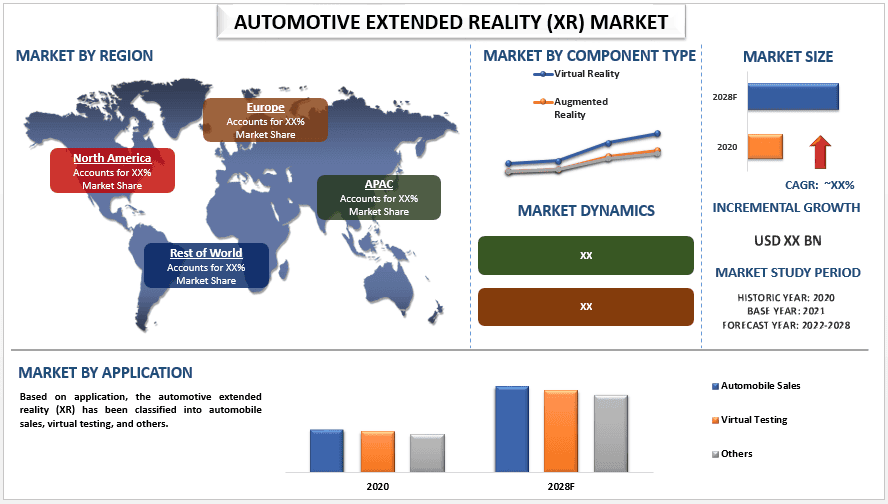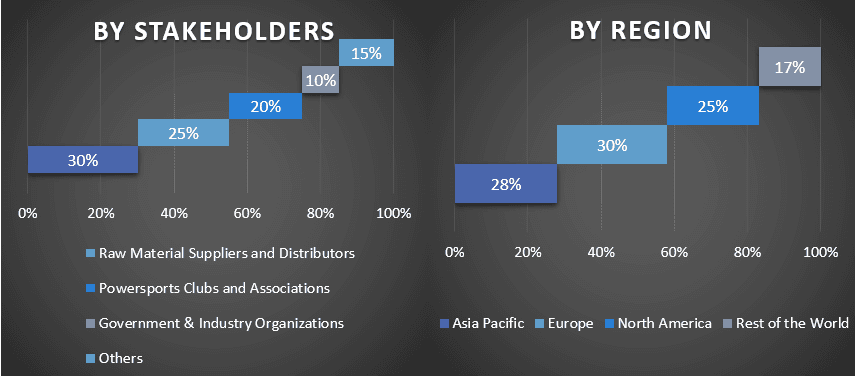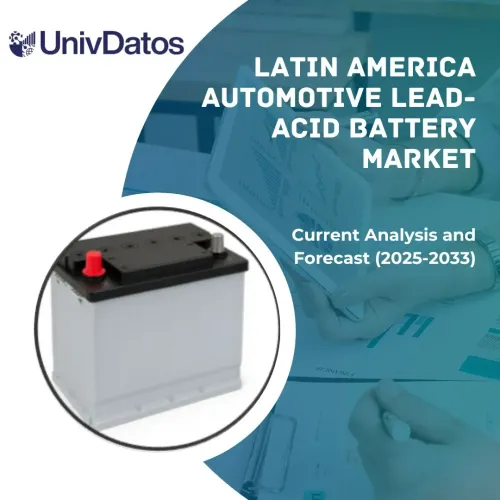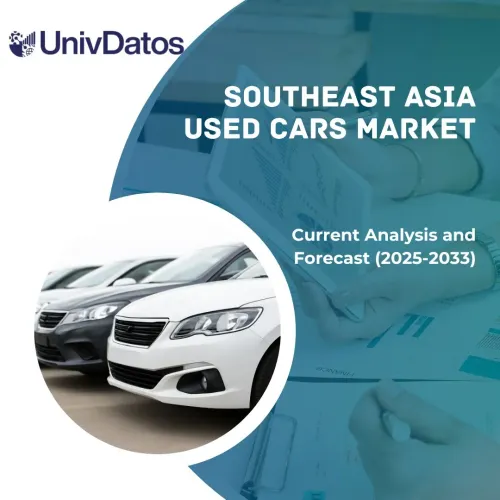- Home
- About Us
- Industry
- Services
- Reading
- Contact Us
Automotive Extended Reality (XR) Market: Current Analysis and Forecast (2022-2028)
Emphasis on Component Type (Virtual Reality, Augmented Reality, and Mixed Reality); Application (Automobile Sales, Virtual Testing, and Others); and Region/Country

Global Automotive Extended Reality (XR) Market is expected to grow at a significant rate of around 5% during the forecast period. The automotive extended reality (XR) market refers to the use of virtual and augmented reality technologies in the automotive industry. The market is expected to grow significantly in forecast period due to several driving factors, including increased demand for advanced in-car experiences: With the growth of technology and increasing consumer demand for advanced in-car experiences, automakers are investing in XR technologies to create innovative and engaging in-car environments. XR technologies, such as virtual and augmented reality, have advanced rapidly in recent years, making them more accessible and cost-effective for the automotive industry. Additionally, XR technologies can help enhance safety and convenience in vehicles, such as using heads-up displays and driver assistance systems. As the trend towards electric and autonomous vehicles continues to grow, XR technologies are expected to play a key role in the development and implementation of these vehicles.
Overall, the increasing demand for advanced in-car experiences, advancements in XR technologies, growing demand for safety and convenience, increased use of XR in automotive design and manufacturing, and the growing trend towards electric and autonomous vehicles are driving the growth of the automotive XR market.
Apple, Inc., Microsoft, Google LLC, Meta, Intel Corporation, Accenture, Qualcomm Technologies, Inc., Koninklijke Philips N.V., SphereGen Technologies, and AugRay LLC. are some of the key players in the market. Several M&As along with partnerships have been undertaken by these players to facilitate customers with hi-tech and innovative products/technologies.
Insights Presented in the Report
“Amongst component type, virtual reality, category to witness higher CAGR during the forecast period.”
Based on type, the market is segmented into virtual reality, augmented reality, and mixed reality. Virtual reality (VR) has the highest growth rate in the automotive extended reality (XR) market for various reasons as VR offers an incredibly immersive experience that allows users to fully engage with and interact with a virtual environment. This makes VR a valuable tool for automotive companies for product demonstrations, virtual test drives and other marketing activities. As VR technology continues to improve, more and more companies are exploring the use of VR in their operations. Furthermore, as compared to traditional methods of product demonstrations, VR is more cost-effective. These factors, among others, contribute to the growth of VR in the automotive XR market and explain why VR has the highest growth rate among all the categories in this market.
“Amongst application, the virtual testing to witness higher CAGR during the forecast period.”
On the basis of drive type, the market is categorized into automobile sales, virtual testing, and others. Virtual testing in the Automotive Extended Reality (XR) market has the highest growth rate because it offers numerous benefits to automakers and suppliers. Virtual testing enables automakers to perform realistic simulations of their vehicles in a virtual environment before actual physical testing. This helps to reduce development time, improve product quality, and reduce costs. Virtual testing allows automakers to test various vehicle parameters such as aerodynamics, suspension, and engine performance in a controlled environment. This enables them to quickly identify and rectify any issues, without the need for actual physical prototypes, which are expensive and time-consuming to produce. Additionally, virtual testing helps to reduce the risks associated with physical testing, such as vehicle damage and safety concerns. It also provides automakers with the ability to test multiple variations of a vehicle in a shorter period, reducing the time to market. Overall, the benefits of virtual testing are driving the growth of the virtual testing category in the Automotive Extended Reality (XR) market.
“North America has one of the highest growth rate in the market”
North America has one of the highest growth rates in the automotive extended reality (XR) market for several reasons. Some of the key factors contributing to this growth include North America is home to many of the world’s leading technology companies, and these companies are investing heavily in the development of XR technology. This has led to the creation of innovative and sophisticated XR products and solutions for the automotive industry. Additionally, The North American economy is robust, and this has enabled businesses and consumers to invest in XR technology for their vehicles. This has created a large market for XR products and services, which has driven the growth of the automotive XR industry. Furthermore, the government in North America has been supportive of the development and implementation of XR technology, providing funding and tax incentives for companies that invest in this technology. In conclusion, the growth of the automotive XR market in North America is driven by a combination of advanced technology, a strong economy, growing demand, and government support.
Reasons to buy this report:
- The study includes market sizing and forecasting analysis validated by authenticated key industry experts.
- The report presents a quick review of overall industry performance at one glance.
- The report covers an in-depth analysis of prominent industry peers with a primary focus on key business financials, product portfolio, expansion strategies, and recent developments.
- Detailed examination of drivers, restraints, key trends, and opportunities prevailing in the industry.
- The study comprehensively covers the market across different segments.
- Deep dive regional level analysis of the industry.
Customization Options:
The global automotive extended reality (XR) market can further be customized as per the requirement or any other market segment. Besides this, UMI understands that you may have your own business needs, hence feel free to contact us to get a report that completely suits your requirements.
Table of Content
Research Methodology for the Automotive Extended Reality (XR) Market Analysis (2022-2028)
Analyzing the historical market, estimating the current market, and forecasting the future market of the global automotive extended reality (XR) market were the three major steps undertaken to create and analyze the adoption of automotive extended reality (XR) in major regions globally. Exhaustive secondary research was conducted to collect the historical market numbers and estimate the current market size. Secondly, to validate these insights, numerous findings and assumptions were taken into consideration. Moreover, exhaustive primary interviews were also conducted, with industry experts across the value chain of the global automotive extended reality (XR) market. Post assumption and validation of market numbers through primary interviews, we employed a top-down/bottom-up approach to forecasting the complete market size. Thereafter, market breakdown and data triangulation methods were adopted to estimate and analyze the market size of segments and sub-segments of the industry pertains to. Detailed methodology is explained below:
Analysis of Historical Market Size
Step 1: In-Depth Study of Secondary Sources:
Detail secondary study was conducted to obtain the historical market size of the automotive extended reality (XR) market through company internal sources such as annual reports & financial statements, performance presentations, press releases, etc., and external sources including journals, news & articles, government publications, competitor publications, sector reports, third-party database, and other credible publications.
Step 2: Market Segmentation:
After obtaining the historical market size of the automotive extended reality (XR) market, we conducted a detailed secondary analysis to gather historical market insights and share for different segments & sub-segments for major regions. Major segments are included in the report as component type and application. Further country-level analyses were conducted to evaluate the overall adoption of testing models in that region.
Step 3: Factor Analysis:
After acquiring the historical market size of different segments and sub-segments, we conducted a detailed factor analysis to estimate the current market size of the automotive extended reality (XR) market. Further, we conducted factor analysis using dependent and independent variables such as various component type, and applications of automotive extended reality (XR). A thorough analysis was conducted for demand and supply-side scenarios considering top partnerships, mergers and acquisitions, business expansion, and product launches in the automotive extended reality (XR) market sector across the globe.
Current Market Size Estimate & Forecast
Current Market Sizing: Based on actionable insights from the above 3 steps, we arrived at the current market size, key players in the global automotive extended reality (XR) market, and market shares of the segments. All the required percentage shares split, and market breakdowns were determined using the above-mentioned secondary approach and were verified through primary interviews.
Estimation & Forecasting: For market estimation and forecast, weights were assigned to different factors including drivers & trends, restraints, and opportunities available for the stakeholders. After analyzing these factors, relevant forecasting techniques i.e., the top-down/bottom-up approach were applied to arrive at the market forecast for 2028 for different segments and sub-segments across the major markets globally. The research methodology adopted to estimate the market size encompasses:
- The industry’s market size, in terms of revenue (USD) and the adoption rate of the automotive extended reality (XR) market across the major markets domestically
- All percentage shares, splits, and breakdowns of market segments and sub-segments
- Key players in the global automotive extended reality (XR) market in terms of products offered. Also, the growth strategies adopted by these players to compete in the fast-growing market
Market Size and Share Validation
Primary Research: In-depth interviews were conducted with the Key Opinion Leaders (KOLs) including Top Level Executives (CXO/VPs, Sales Head, Marketing Head, Operational Head, Regional Head, Country Head, etc.) across major regions. Primary research findings were then summarized, and statistical analysis was performed to prove the stated hypothesis. Inputs from primary research were consolidated with secondary findings, hence turning information into actionable insights.
Split of Primary Participants in Different Regions

Market Engineering
The data triangulation technique was employed to complete the overall market estimation and to arrive at precise statistical numbers for each segment and sub-segment of the global automotive extended reality (XR) market. Data was split into several segments & sub-segments post studying various parameters and trends in the areas of component type and application in the global automotive extended reality (XR) market.
The main objective of the Global Automotive Extended Reality (XR) Market Study
The current & future market trends of the global automotive extended reality (XR) market were pinpointed in the study. Investors can gain strategic insights to base their discretion for investments on the qualitative and quantitative analysis performed in the study. Current and future market trends determined the overall attractiveness of the market at a regional level, providing a platform for the industrial participant to exploit the untapped market to benefit from a first-mover advantage. Other quantitative goals of the studies include:
- Analyze the current and forecast market size of the automotive extended reality (XR) market in terms of value (USD). Also, analyze the current and forecast market size of different segments and sub-segments
- Segments in the study include areas of component type and application.
- Define and analysis of the regulatory framework for the automotive extended reality (XR)
- Analyze the value chain involved with the presence of various intermediaries, along with analyzing customer and competitor behaviors of the industry.
- Analyze the current and forecast market size of the automotive extended reality (XR) market for the major region.
- Major countries of regions studied in the report include Asia Pacific, Europe, North America, and the Rest of the World.
- Company profiles of the automotive extended reality (XR) market and the growth strategies adopted by the market players to sustain in the fast-growing market
- Deep dive regional level analysis of the industry.
Related Reports
Customers who bought this item also bought










